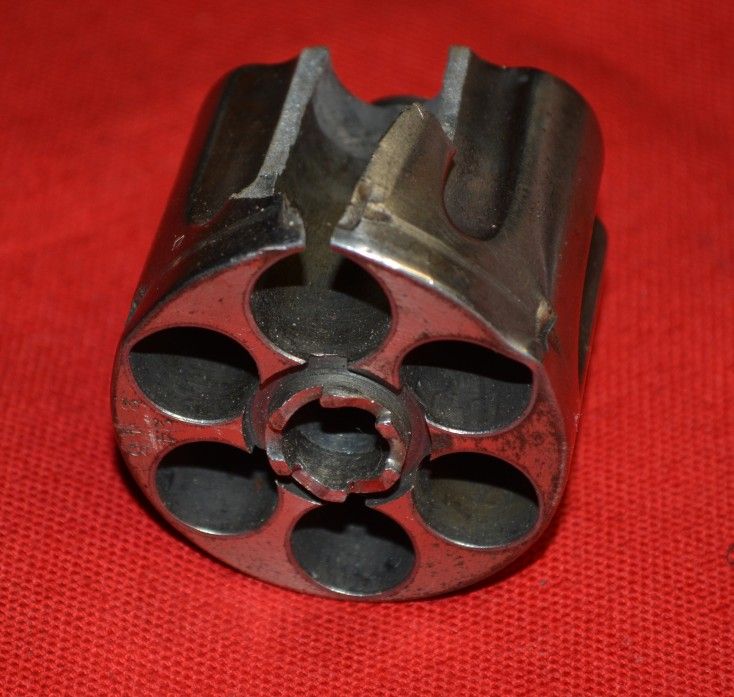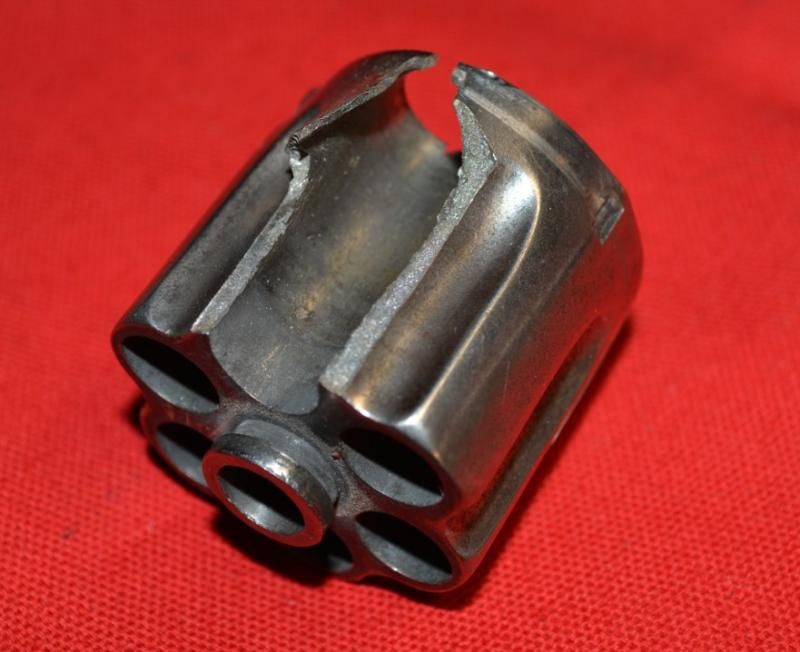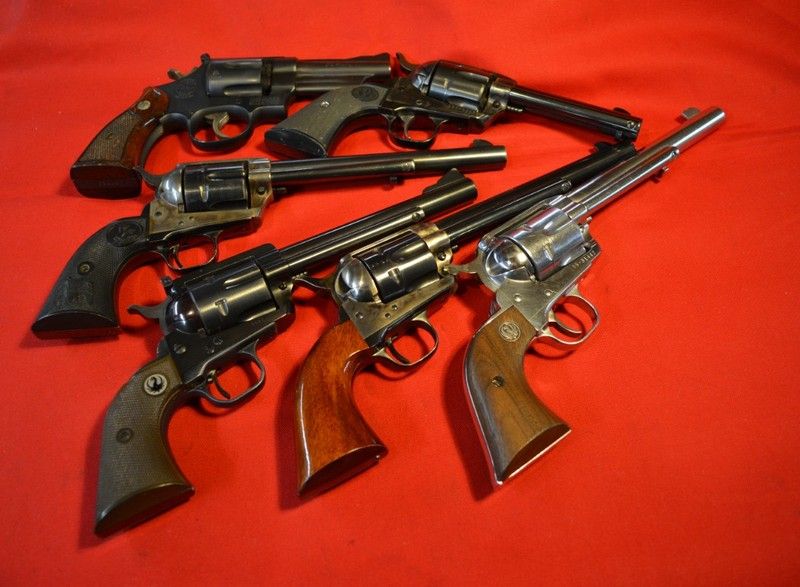Howdy Again
Let's back up the bus a moment.
We have been arguing apples and oranges here.
TheGuyOfSouthamerica: I did not realize you were trying to compare the strength of a 357 Magnum Pietta to the strength of a 357 Magnum Ruger. Looking back at your first post I should have realized it.
The fact is, it is a moot point. It does not matter which one is stronger, they are both very strong. Sometimes folks ask if it is OK to shoot full power 357 Magnum ammunition in a 357 Magnum replica of a Colt, such as an Uberti or a Pietta. They ask if they should just be shooting light Cowboy loads in them.
A Colt sized single action revolver is a big gun, and it has a big cylinder. Colt began chambering the Colt Single Action Army for the 357 Magnum cartridge shortly after the cartridge was developed, way back in 1935. Since 1935 metallurgy has advanced quite a bit and modern cylinders are even stronger than the 1935 Colt cylinders. Questioning the strength of a SAA sized cylinder when chambered for a large caliber such as 45 Colt is one thing, because the web between chambers will be much thinner than the web between chambers with smaller calibers. But it is not a cause for concern with a large cylinder, such as the Colt SAA or it's Italian made clones when chambered for the smaller diameter 357 Magnum. Of course, good sense has to be applied. Any gun can blow up if its design limits are exceeded.
Just for the fun of it, I just grabbed a S&W Model 28, which is a large frame (N frame to be specific) double action revolver, basically the same size as the original 357 Magnum revolver that S&W built for the brand new 357 Magnum revolver in 1935. Overall diameter of the N frame S&W cylinder is only about .050 larger than a Colt SAA cylinder. In a large caliber such as 45 Colt or 44 Magnum, that is a significant number. For 357 Magnum it does not matter a hill of beans.
OK, let's get back to the question at hand. The webs between chambers (the thinnest point between chambers) of my 357 Mag New Vaquero are running around .140. There is a little bit of variation, but lets call it .140 to keep things simple. The distance from a chamber to the outside of the cylinder is running around .128. This is actually not such an important number as you might think, we will get into why in a little bit.
Just for comparison, the thickness of the web between chambers on the S&W Model 28 is running around .165, and the distance at the thinnest point between chambers and the outside of the cylinder is running about .128. Again, the second number needs a little bit more explanation, we will get into that in a minute.
OK, let's look at, left to right, the Cattleman, the big, 'original model' Vaquero, and the Colt SAA cylinders now. All three are chambered for 45 Colt.
Web Thicknesses:
Uberti Cattleman: averaging about .043
Ruger 'Big' Vaquero: averaging about .065
Colt Single Action Army: averaging about .045
Distance from chamber wall to OD of cylinders:
Uberti Cattleman: averaging .065
Big Vaquero: averaging .078
Colt SAA: averaging .058
(I have a pretty big pile of guns without cylinders out on the bench right now, I hope I don't get them confused).
OK, now it's time to talk about why that second number is not as significant as one might think.
The thinnest cross section of metal on most revolver cylinders is usually not the web between chambers, nor is it the section between the chamber and the outer diameter of the cylinder. The thinnest spot is usually the thickness of metal between the slot cut into the cylinder for capturing the bolt and an underlying chamber. When a cylinder ruptures from an over pressure event, that is usually the place the failure starts, and then the crack propagates from there.
I first became aware of this phenomenon about ten years ago in a conversation I had with an engineer who was working for Ruger at the time. He told me they had decided to test a Vaquero with ever hotter loads until the cylinder burst. They took high speed video and I remember he told me that when they played back the video in slow motion they could see plain as day that the rupture started at the bolt locking slot, then the crack spread forward and back along the thin cross section between the chamber and the outer diameter of the cylinder. Then, it wasn't finished, both chamber walls on either side of the chamber in question folded out like hinges at their narrowest point. As these walls folded, they ruptured, and then two more cracks appeared, at the bolt locking slots of the two adjacent chambers. This pair of cracks also propagated forward and back along the thinnest part of the chambers, and two chunks of steel exploded off the cylinder, leaving three chambers blown open.
Here is the cylinder from a very old Merwin Hulbert revolver. A friend managed to blow it up and he gave me the cylinder. (Really, I didn't do it)
You can plainly see how a crack started at that spot on a locking slot, then the crack spread forward and back, splitting the chamber. You can also see the over pressure event caused the metal at the locking slots of the two adjacent chambers to distort. If the pressure had been a bit higher, you can see how two cracks would have formed at those two chambers, and the two adjacent walls would have let go too.


If you look carefully at the position of the locking slots on most revolver cylinders, you will see that one of the edges of the slot lines up just about perfectly with the center of the chamber below it. Nobody did this on purpose, the position of the slot was dictated by the position of the bolt in the frame, and that was dictated by how the parts fit together inside. Just a bad coincidence. But this 'feature' has been incorporated in many revolver designs for well over 100 years. So that very thin point on most revolver cylinders is its Achilles Heel. Engineers today call a design flaw like that a Stress Riser, and when metal is stressed too much, that is where a rupture is likely to occur. It will then spread from there.
It is difficult for me to get a good measurement on how thick the metal is between a chamber and the thin spot under a locking slot. It is a curved surface, and the depth probe on most calipers is squared off, so any measurement will have a built in error. There are special calibers designed for this type of measurement, but I don't have one.
Anyway, let's look at our Cattleman, Vaquero, and Colt cylinders again and try to get a measurement by subtracting the depth of the cut from the thickness between the chamber and the outer diameter of the cylinder.
Cattleman: .065 - .037 = .028
Vaquero: .078 - .050 = .028
Colt: .058 - .030 = .028
Pretty scary stuff. There is a tiny section at each chamber of these cylinders that is only about .028 thick. To be fair, this spot will probably only rupture under extreme conditions. Normally the thickness of the surrounding steel will 'bridge' the gap, that is why revolvers are not blowing up all the time. Also, my measurement technique was admittedly less than ideal, so these numbers could easily be off a bit. But these numbers do say something. Subject a chamber to too much pressure, and that very thin piece of metal may start a cascade that results in a ruptured cylinder.
There is one more wrinkle to this story. Apparently (I do not have any documentation on this) Ruger realized this a long time ago. Carefully check out the position of the locking slot on a Ruger cylinder. The position of the locking slot has been shifted a bit. On my 45 Colt Vaqueros the straight edge of the locking slot is not directly over a chamber, it is shifted over a small amount. There is a bit more of a shift on the 357 Mag New Vaquero. I just grabbed an old Three Screw 44 Mag Blackhawk made in 1958 and the slot has been shifted a little bit on it too. The only double action Ruger I own is a GP 100 I bought used a bunch of years ago, and the slots on it are way out of line with the center of the chambers. What this means is by shifting the position of the slot slightly, the thinnest section of metal on a Ruger cylinder has been increased. How much depends on how far the slot has been shifted. Bill Ruger was one smart guy. Or his design engineers were real smart guys.
End of this very long and wordy post.
The pile of revolvers got bigger as I went along. Just for fun, here is a photo of the pile of revolvers used for this post. No revolvers were injured in taking this photograph.
P.S. I should add a disclaimer. I have only been talking about mechanical dimensions and have ignored factors such as the strength of the individual steel alloys used, hardness achieved through heat treating, and probably a bunch of other things. But from a purely mechanical dimension standpoint, those are my thoughts and the numbers I have come up with.
P.P.S. If you grab a seven shot revolver, you will notice that the odd number of chambers shifts the position of the locking slots dramatically. The only seven shot revolver I own is a S&W Model 686-6 that I bought a couple of years ago. The locking slots are very nicely centered over the webs between chambers and they are far away from the thin sections of the chambers between the chamber and the outer diameter of the cylinder.




